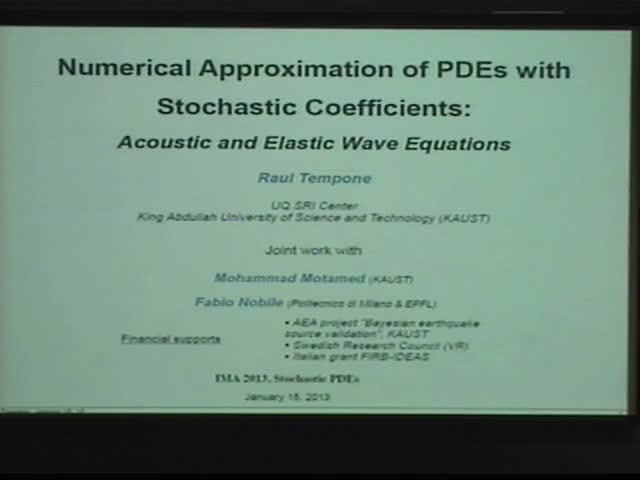Numerical Approximation of PDEs with Stochastic Coefficients
Presenter
January 15, 2013
Keywords:
- Stochastic partial differential equations
MSC:
- 60H15
Abstract
Partial Differential Equations with stochastic coefficients are a suitable tool to describe systems whose parameters are not completely determined, either because of measurement errors or intrinsic lack of knowledge on the system.
In the case of linear elliptic PDEs with random inputs, an effective strategy to approximate the state variables and their statistical moments is to use polynomial based approximations like Stochastic Galerkin or Stochastic Collocation method. These approximations exploit the high regularity of the state variables with respect to the input random parameters and for a moderate number of input parameters, are remarkably more effective than classical sampling methods. However, the performance of polynomial approximations deteriorates as the number of input random variables increases, an effect known as the curse of dimensionality. To address this issue, we propose strategies to construct optimal polynomial spaces and and related generalized sparse grids.
In the second part of this talk we propose and analyze a Stochastic Collocation method for solving the second order wave equation with a random wave speed. The speed is piecewise smooth in the physical space and depends on a finite number of random variables. We consider both full and sparse tensor product spaces of orthogonal polynomials, providing a convergence analysis. In particular, we show that, unlike in elliptic and parabolic problems, the solution to hyperbolic problems is not in general analytic with respect to the input random variables. Therefore, the rate of convergence may only be algebraic. Faster convergence rates are still possible for some quantities of interest and for the wave solution with particular types of data.
We will finally discuss the use and analysis of discrete least-squares projection on a polynomial space starting from random, noise-free observations. In particular, we are interested in their application within Uncertainty Quantification for computational models.
